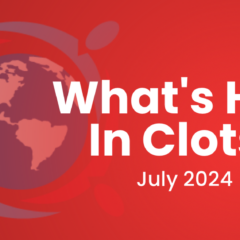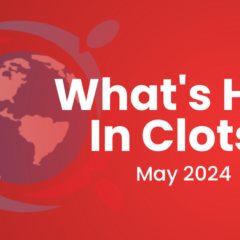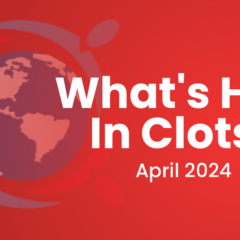Last updated on
What’s Hot in Clots – June 2024
Key Updates in Thrombosis
Table of Contents
- Andexanet alfa for treatment of intracerebral hemorrhage in patients taking factor Xa inhibitors: Do we have a winner?
- Machine learning for determining the risk, diagnosis, and outcomes of venous thromboembolism: The good, the bad, the ugly!
- Statins associated with reduced risk of VTE in patients with cancer
- Extended DAPT after ACS?
I don’t know about you but in the US Northeast, I feel like we hopped from winter to summer… the spring was just too short. Here are my summaries for this month:
Andexanet alfa for treatment of intracerebral hemorrhage in patients taking factor Xa inhibitors: Do we have a winner?
To start backwards, it depends on how you look at things. Strictly speaking, this long-awaited trial of andexanet alfa versus control (in most cases, prothrombin complex concentrate) met its primary efficacy outcome. If you look more closely, this finding was driven by a surrogate marker (hematoma expansion), while neurological recovery and death did not significantly differ between the groups. However, there were more thrombotic events, including ischemic strokes, with andexanet alfa compared with control. Do we have a clear winner? I wouldn’t think so. Read more.
Machine learning for determining the risk, diagnosis, and outcomes of venous thromboembolism: The good, the bad, the ugly!
This was a systematic review of existing studies, and the good thing with machine learning tools was that they outperformed tools like traditional regression for prediction on many occasions. The bad news is that their external validity is often limited. Simply put, if one developed a machine learning tool, it was rare that it performed similarly well across various databases – or at least it was not proven. If that’s only bad, then what is ugly? Lack of consistent and transparent reporting. We need to make these models more than black boxes and help non-savvy readers with clear simple descriptions. Many folks who are not aeromechanics have a broad sense of car engines. Not sure I can say the same about most clinicians or even clinician-investigators and machine learning models! Read more.
Statins associated with reduced risk of VTE in patients with cancer
In a nested case-control study of patients with cancer, use of statins was associated with a lower risk of subsequent venous thromboembolism (VTE). Unlike anticoagulants, statins do not have an appreciable risk for excess bleeding. Could this be a new option worthy of clinical trials? Read more.
Extended DAPT after ACS?
When I was a resident and fellow, the traditional teaching was that dual antiplatelet therapy (DAPT) would be the cornerstone of management for patients with acute coronary syndromes (ACS). Over time, more potent P2Y12 platelet receptor antagonists emerged. In a way, more was more…but we are seeing the opposite in recent years. This trial of over 7,000 patients in China who were stable for at least 6 months post-ACS with DAPT showed that clopidogrel monotherapy, compared with clopidogrel + aspirin, resulted in less bleeding, without an excess in ischemic events. Yet another recent trial suggesting less is more. Read more.
For more updates, be sure to subscribe to get the latest updates each month.
Find this information helpful? Please consider making a small donation in support of thrombosis education & resources.

Behnood Bikdeli, MD, MS
Cardiologist, Section of Vascular Medicine, Division of Cardiovascular Medicine, Brigham and Women’s Hospital
Investigator, Thrombosis Research Group, Division of Cardiovascular Medicine, Brigham and Women’s Hospital
Instructor, Harvard Medical School
Investigator, Yale/ YNHH Center for Outcomes Research and Evaluation, Yale School of Medicine
Investigator, Cardiovascular Research Foundation



